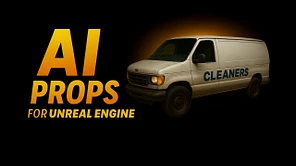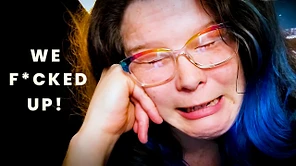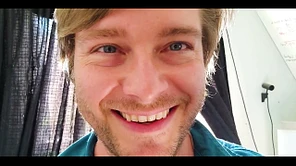✒️SCENE 14✒️
Zola is checking on their grow house, while Oli is worried about their dwindling supplies. Tensions are rising!
This scene is in a sequence of "everyday life" scenes where we see how our five heroes have survived the last two years. In the sequence, we explore their food supply dwindling, their water and energy issues, and the uncertainty of whether fixing the Nuvitta Network is a good idea.
Because two years is a long time when the world’s gone to shit, we felt like the sequence this scene falls into was important. How do they eat, what do they eat? Where do they live? What's their day-to-day like? How do these seemingly unconnected people work as a family unit?
ZOLA & OLI
In this particular scene, we wanted to explore the subtle character dynamic between Zola and Oli, hinting at their friendship, trust, and fears—all with little dialogue. When you're around people who want to succeed with you, silence can be a powerful communicator.
It’s a simple scene on paper, but if done properly in the final edit, it provides a nice slowdown from the first act and previous action scenes. It also shows some nice independent and collective worries for each character regarding their dwindling supply situation.
ANIMATING THE SCENE
MOCAP & SCENE PACING
Animating this scene was a fun one. It was our first "talkie."
We needed to animate this scene to work through the production workflow of animating a talking scene with one mocap suit.
How do you get audio into UE5? What does the pipeline look like to incorporate Eleven Labs Voice2Voice?
We found that rehearsal was important so the timing when we got into the scene pacing wasn’t so terribly off. It was refreshing to discover the power of animating and editing for a shot; as opposed to animating for a scene.
If we were shooting this live, we’d have shot it with a traditional coverage style of shooting. I'd have estimated at least half a 10-hour day, if not the full day, for this scene.
With the real-time animation workflow, we were able to rehearse and mocap the scene in 2 hours and have pacing for the shot animation edit done the following day.
ENVIRONMENTS
The big thing I wanted to dip into was the importance of environment building. The previous scenes were done with very sparse set design. While we’d made some strides with the actual workflow, it was important that we fill the room with stuff.
Having nanite and learning you can put blueprints inside of blueprints was a game-changer. So was having access to KitBash3D and Megascans.
It was really important to get some depth in the scene. Ambiance helps create a particular character element that’s unspoken on screen, and we wanted to try our hand at it for the first time.
SPRITES & FLIPBOOKS
This is a minor detail, but this scene helped us learn the power of the flipbook workflow in UE5. The little glowing screens on the lockers were our first little foray into animated screens for this project. The flipbook and sprite workflow was shockingly simple, and we'll definitely be using more of those.
THE GROW ROOM
The choice to have this scene in a grow room served two purposes. We knew we needed to explain where their food supply came from. And we wanted to play with intense lighting.
Because the team set up their bunker in a Network Building, we decided they’d made a home in an office building—a place with a lot of rooms, space, and fluorescent lighting. We also knew that because they were 100 years in the future, chances were they’d have some better growing techniques than present day.
The other driving force for this scene was that we really wanted to emulate some of the lighting choices done in one of our favorite movies, Attack The Block.
Jayson was adamant about using colored fluorescents in the scene, and doing so in a grow room was a nice homage/touch.
In future renditions I'd like to explore adding more hydroponic systems hanging from the ceiling, maybe build out a wall unit and a water system that we could get cool inserts from.
AI WORKFLOW
It was in this scene we realized we could do a pretty standard Stable Diffusion AI process on top of our characters. We’d tested SD in our previous scenes but did it for each shot, which was time-consuming and generally messy on the file management side.
For this scene, we batched the entire sequence and then just spot cleaned frames where the AI might have given Oli a man's face or made Zola too feminine. Because we're editing image sequences, updating the shot was faster this way.
The technique offers a subtle AI filter that just helps the Metahumans feel a little less plastic and a little more "squishy." It also does some really clever color correction that speeds up the process.
The other AI technique that was fun to play with in this scene was the use of Eleven Labs' Voice2Voice option. We learned that when you rush lines or mumble things, the AI struggles to capture the emotion. But it did its job.
It was also fun coming up with new lines and adding elements to the scene that weren't in the script. The "Computer play my jams" and "Playing Zola's jams" were a fun spice that helped the opening of the scene. And it was done with text-to-speech, something we would have had to ADR at a later date to make happen.
But with AI, we did it right in the edit.
MOVING FORWARD
We learned some subtle things on this one, but I think when they all come together, they compound into more tools that will help us fine-tune this project into shape.
Now, even though we tried our hand at interior environments, you can still feel the emptiness in the environment. I think adding more to the wall textures and filling some of the empty space in the frame with more “human clutter” will amp up the space a bit more.
There is also a desperate need to learn cloth simulation—the joint action in this scene is definitely in need of work.
But not too shabby for the first pass.
I'm excited to revisit this one when we circle back for the full production.
THOUGHTS?
What were your thoughts on this one? Any tips or ideas to make it better? Any feedback helps us become better so that when it comes time for full production of the episode, things smooth out, feel fuller, and look great.











